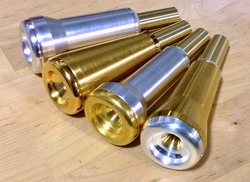 A lot of people first think 5MM is a reference to the metric system of measurement. However, the "5" represents the five major components of the mouthpiece that determine comfort, playability, tone, projection, intonation tendencies, etc. These are the Rim, Cup, Throat, Backbore and Body. There is a sixth component of the system known as the Nut, which prevents the Backbore from coming unscrewed and fills the visual external gap to the instrument receiver. What is the "MM"? This represents MODULAR MOUTHPIECE. The idea is simple. Start with your current size in the 5MM System, then try various options that previously did not exist in other mouthpieces to see what fits you better. The goal is to improve playability in terms of ease, clarity of attacks, intonation, tone and projection. You can also alter these attributes to achieve a very unique sound, attack and projection pattern depending on your needs. What is available in the 5MM that is not possible with other mouthpieces? Well, just about everything! The 5MM offers new options that do not exist in other brands and we will introduce more innovations year after year. Now you can create a shallow mouthpiece that produces a huge sound. Or a small rim diameter with solid fat attacks. How about a mouthpiece that uses very little air while creating a big broad tone? Yes, all of this is possible with the 5MM System. 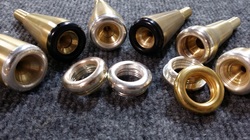 5MM Rims The Rim is the most important element of any brass mouthpiece. Your body and mind have become accustomed to the shape and size of your current rim allowing muscle memory and reflex to provide the results you desire. Or do they? In many cases, your current rim selection may not be the best fit for your unique embouchure, dental structure, lip composition, etc. You may greatly benefit from trying a new rim based on the parameters of your original. Some players increase tonal color, range and endurance by moving to one size larger on the inside diameter. Others may benefit from a wider outside diameter or even different radii on the inside or outside, thus changing the overall "flatness" or "roundness" that presses against your teeth. Not sure what is right for you? Just ask us and we'll point you in the right direction based on your current equipment and performance results. One thing we know for sure is that we can make the right rim for you. We have the experience, tools and expertise to take your playing to the next level with just a few minor adjustments to your mouthpiece. 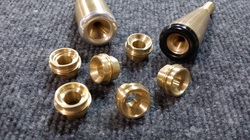 5MM Cups Our "Compression" series cups improve attacks in all registers without sacrificing range and endurance. Our "Triple" series cups improve attacks while giving you a smoother velvety tone for those times when you want to sound more complex. And our "Original" series gives you exactly what you experienced in your previous mouthpiece. 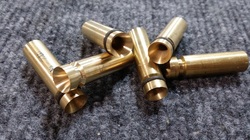 5MM Throats Our Modular system offers a major innovation for brass players, the ability to test every Throat size! We estimate that around 90% of all players are not using a mouthpiece designed to their optimum throat diameter. Why is this important? The inside diameter determines air flow and tone color. Too tight and you may sound shrill, experience diminished dynamics and have trouble in the low register. Too large? Well, very few standard mouthpieces offer a throat that is too large since the range of playable options is literally 40 sizes larger than a #26 throat. Let's just say that you will gain dynamic range (softer and louder), tone color, breadth of tone and improve your technique while strengthening your embouchure simply by moving to one throat size larger every few months for the first few years. Relying on small throats from #21 to #30 is the primary cause of limited flexibility within the full range of the instrument as well as an overly bright tone. Where do you start with throat sizes? I recommend ordering your original throat along with two others that are at least one size larger than the previous to get started. Work your way into larger throats gradually and consider stepping down one size for rigorous performances until you are ready to move up to the next size. What are compression throats? I have developed compression shape to the entrance of the throat. The throat segment of the 5MM was deliberately designed to allow for this option. By altering the "funnel" curve at the entrance, it is possible to compress your air stream to become faster when it reaches the smallest inside diameter. I currently offer three compression shapes with more to come in the future. Shape C - increased air velocity with less effort resulting in a full tone and easier upper register Shape E - brighter and more effective in the upper register than shape C Shape H - easier attacks in all registers with a slightly air "Chet Baker" tone 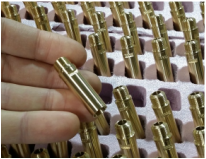 5MM Backbore Think of the Backbore as an extension of the Throat and the beginning of the Leadpipe. This crucial component is the physical acoustic link between the mouthpiece and the instrument. By optimizing the Backbore, you are essentially linking these two different objects to become one seamless acoustic instrument. However, the vast majority of players are playing with a mouthpiece that is mismatched to their instrument. How do I know? I work with thousands of brass players from around the world and only in certain instances are the acoustics even remotely close to optimum. How can this be true? Think about this scenario, you purchased a fine top of the line Bach or Yamaha trumpet and matching mouthpiece in 1982 and loved it. A few years later, you purchased Schilke 14A4A mouthpiece because you heard that the lead player in your favorite band was using the same size. In the early 90's you decided you wanted a bigger, fatter tone so you purchased a Monette B12 and ten years later switched to the B2S3 Prana. Sound familiar? What makes you think any of these aftermarket mouthpieces were designed to fit a Strad 37 or Xeno 8335? I know for a fact that they don't fit properly. And they do not produce optimum results acoustically. In reality, each of these scenarios playing various mouthpieces in your original horn created some results you did not prefer at the time whether you noticed or not. The reason is simple, the Backbore of each different mouthpiece does not always transition to the Venturi of the leadpipe, nor does it produce the optimum (or zero) Gap. Don't take my word for it, dig out your shoe box of mouthpieces and start measuring! What can you expect from matching the Backbore taper to your individual trumpet using the 5MM System? Improved CONSISTENCY is the number one benefit. Next... improved intonation, then flexibility and slotting. You may also adjust for intonation tendencies by altering the value found at the end of the throat and the beginning of the backbore. I'll discuss this in depth in a future post. 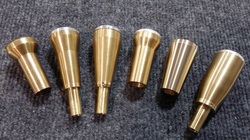 5MM Body (and Nut) The 5MM Body is the skeleton or frame work of the entire system. This component is responsible for added efficiency, which translates into easier wide interval leaps, increased dynamic range and improved endurance. I have written extensively on the subject of "Standing Wave Efficiency" within my online blog and there are numerous YouTube videos explaining the physics behind SWE Technology and how I have applied this concept to brass instruments. So which Body style is right for you? I specifically designed style "A" to be the optimum efficiency, weight and aesthetic design to fit most trumpets. This design (and styles B and C) tapers down to 5/8" with a nut option to transition to a 9/16" receiver, which is the most common size on almost all factory built horns. Those of you playing a custom horn with a 5/8" receiver may opt for the cylindrical nut. Around 1150 of you are playing Harrelson trumpets and a few hundred of our trumpets were built with a 3/4" receiver, which would require styles E or I as these taper to 3/4". Need more audible feedback? Then choose styles C or our Lightweight series as these lose more energy giving the player more feedback behind the bell. Need more projection? Choose style I for maximum efficiency and projection. 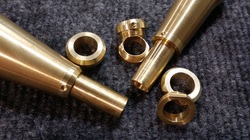 What's with the Nut? The nut segment of the 5MM holds the backbore in place while creating a flush fit between the receiver and body. However, it is necessary to measure the external visual gap with the mouthpiece in place to determine the correct nut fit. For this reason, we have compiled a list of measurements to offer size range options which provide an educated guess for the actual nut length. There is no way to know for certain if a nut will completely fill the gap without either measuring or testing it on the exact instrument in which it will be used. For this reason, we have developed a Nut Size Gage on our 5MM Tool to solve this problem. When you order your 5MM, you have the option of ordering the 5MM Tool and holding your Nut shipment until AFTER you have measured all instruments that will be used with your 5MM Kit. This is the simplest method of finding the best fit if you cannot visit one of our shops in Minneapolis or Denver. Choosing a 5MM Kit
Find the Modular Mouthpiece kit to fit your needs by clicking the photo below...
1 Comment
Foi muito legal saber todas essas informações. Assunto muito legal.
8/19/2016 07:19:58 pm
Reply
Your comment will be posted after it is approved.
Leave a Reply. |
Jason Harrelson
Inventor, Musician, Educator and Founder of Harrelson Trumpets, Trumpet Momentum and Harrelson Momentum. Archives
July 2024
|

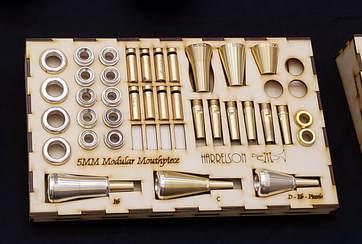

 RSS Feed
RSS Feed
